Description of tomato diseases and their treatment
Diseases of the tomato develop gradually, so not every summer resident is able to recognize the appearance of pathology at its early stage. However, there are several symptoms characteristic of each disease, by which it is possible to determine the developing disease and begin its timely treatment. The main causative agents of various tomato pathologies are viruses, bacteria, fungal infections. They can infect crops while in the soil or spread when irrigated. You can diagnose the disease by looking at the photo, and their treatment will be selected correctly.
Mosaic
This pathology belongs to the viral group. A tomato bush can become infected with this disease through direct contact with aphids - insect vectors of the mosaic, or when planted in soil where the remains of a past sick plant are located. The main symptoms appear on foliage or tomatoes:
- the leaves begin to curl;
- yellowish or brown spots, stripes appear on the surface of the leaf;
- in advanced cases, the leaves dry up;
- the trunk acquires a fragile structure;
- the fruits are covered with round spots;
- when the fetus is cut, necrotic zones, colored green, can be seen.
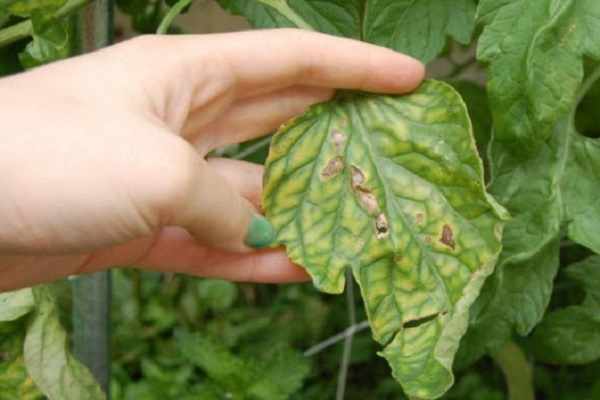
Mosaic mainly affects tomatoes of the indeterminate type, which were grown in seedlings. Infection occurs when the seedlings are transplanted into soil. Also, the virus can be on the surface of seeds used to form seedlings, therefore, before using them, it is necessary to disinfect the planting material.
Unfortunately, no remedy has been developed to help eliminate such diseases of tomato seedlings and formed bushes. All affected bushes should be removed from the site as soon as possible, without laying the plant in the ground, since such a procedure will contribute to the activation of the disease of tomato seedlings in the next season. In order to exclude infection of a healthy bush with mosaics, it is necessary to carry out prophylaxis by disinfecting seeds and soil, observing the optimal indicators of humidity, light and heat.
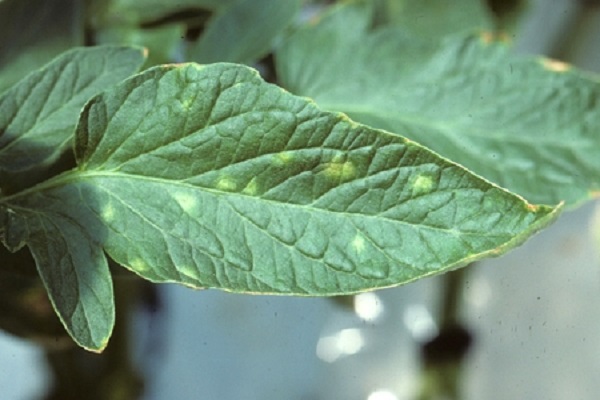
Yellow curl
The spread of the yellow curl virus of tomato leaves occurs through its transfer by whiteflies. The main symptoms are:
- leaves take on a chlorotic appearance;
- the development of the leaf plate does not occur even to average values;
- leaves curl and turn yellow;
- the plant becomes uneven in color;
- ripe tomatoes take on an unmarketable look.

It is not worth treating this disease, as it develops rapidly and can spread to neighboring plants, therefore, the bush should be dug up and burned.When whiteflies spread near the site, it is necessary to control them.
Cladosporium
The people call this disease brown spot. The main feature of this tomato disease is its rapid development and spread. It is caused by a fungus that first settles on the foliage, and then infects tomatoes. This disease is characterized by the following symptoms:

- the appearance on the leaves of concentric spots colored with yellow pigment;
- a brown fluffy bloom forms on the spots;
- gradually the tomatoes turn brown and begin to dry out;
- leaves curl;
- twisted leaves dry and fall off;
- if the lesion occurs during the flowering period, the flowers dry and fall off.
The characteristic symptoms first appear on the foliage located on the lower tiers, and then it spreads throughout the plant.
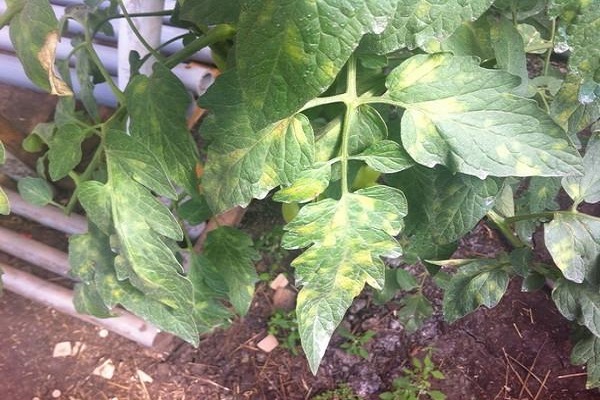
Methods for treating cladosporiosis:
- In 5 liters of water, 0.5 liters of milk and 15 drops of iodine are dissolved. The resulting liquid is carefully processed by the affected plant. Particular attention should be paid to the back of the leaves.
- In a similar way, the affected plant can be sprayed with a decoction made from wood ash and a solution of milk whey.
- Add 1 tablespoon of copper sulfate, 1 tablespoon of polycarbacin and 3 tablespoons of sulfur to a bucket of water. Everything is mixed and sprayed onto the affected bush. This solution can remove diseases of tomato seedlings and adult crops.
- The treatment of tomatoes from diseases can be done with the help of the Bravo preparation, which belongs to a broad spectrum of fungicides.
During the treatment of fungal diseases of tomatoes, it is necessary to disinfect the soil. For this, the prepared solution is poured over the ground in the near-trunk radius.

Powdery mildew
Another tomato disease is powdery mildew. You can recognize the spread of infection by the following symptoms:
- the appearance on the leaves of strange formations, the external signs of which are similar to flour dust;
- such pollination gradually forms into ulcers;
- leaves begin to turn yellow, fall off.
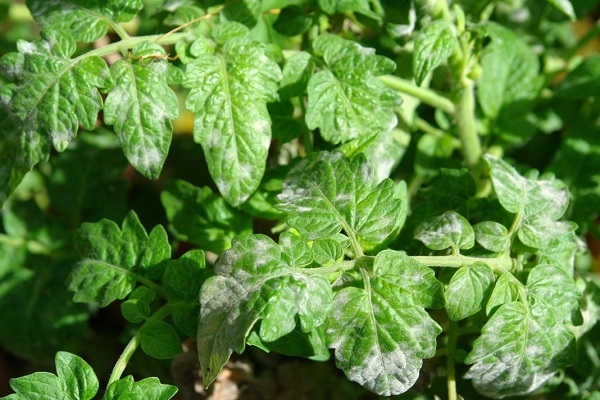
When the first signs of this disease appear in tomatoes, it is necessary to increase the amount of phosphorus and potassium fertilizers introduced into the soil, and also to limit the amount of nitrogenous fertilizing. If such treatment of tomatoes from diseases did not bring a positive effect, the bushes must be sprayed with a solution of soda or potassium permanganate, a decoction of wood ash, and garlic infusion. Topaz or Fundazol protects against a neglected disease.
Vertex rot
The symptoms of the development of these diseases of tomatoes and their treatment do not depend on fungi and pathogenic microflora. Top rot is caused by failure to provide proper plant care. The reason for the appearance of such a pathology is unfavorable environmental conditions, characterized by a deficiency of moisture in the soil, high temperature indicators of the air. Another reason for the spread of top rot is the lack of calcium in the soil, its salinity.
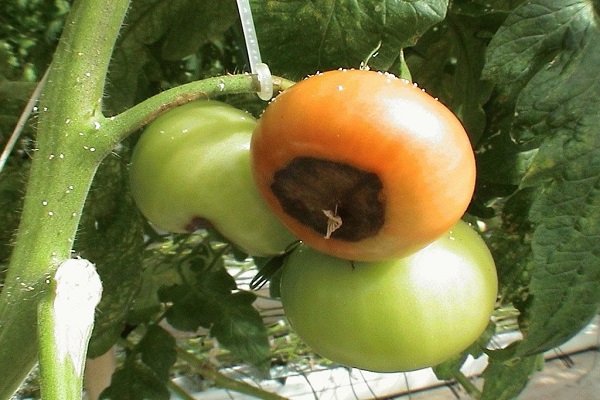
The formation of this disease is accompanied by the appearance of the following symptoms:
- the appearance of brown spots on the top of the tomato;
- decay of the vegetable under the darkened areas of the skin;
- softening of the affected area;
- falling fruit.
If the spots on the tomatoes have acquired a black tint, it means that another fungal disease has joined the top rot.

The fight against this pathology is carried out with the help of regular watering, which does not allow the soil to dry out. It is also necessary to make up for the lack of calcium. For this, calcium nitrate is introduced into the soil. Treatment with calcium solutions must be done in relation to the bush itself.
To do this, dissolve 10 grams of Brexil Ca in a bucket of water.The resulting liquid is sprayed on the leaf.
If the bush passively absorbs nutrients, and also draws out insufficient moisture from the soil, it must be watered with Megafol or Sweet solutions. They activate the described functions, and also facilitate the process of transporting the obtained energy for active ripening of fruits.

Gray rot
A characteristic feature of this disease is the appearance of a gray putrefactive plaque on the trunk. Gradually, the possibility of carrying moisture and nutrients is blocked in the stem. As a result, the vegetative organs of the plant dry out and die off. In advanced cases, gray rot of the fruit develops.
Methods for treating this disease are to process the affected bushes according to the following instructions:
- All damaged areas of the trunk are removed.
- Leaves are also examined for the appearance of rot. If they are damaged, the leaves must also be removed.
- The ailing bush is treated with fungicides.
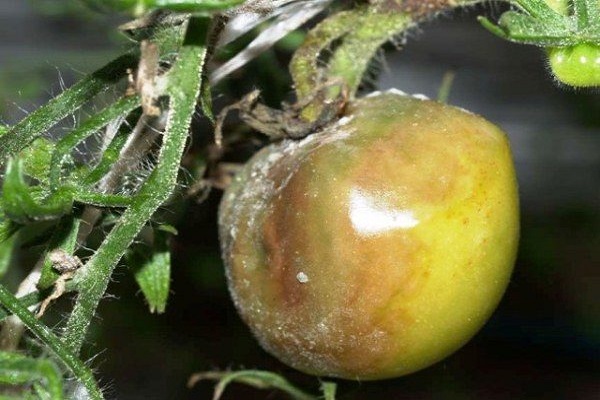
In order to prevent and protect tomatoes from diseases characterized by the spread of rot, the bushes should be treated with Glyocladin.
White rot
You can protect tomatoes from the spread of white rot by knowing its characteristic features:
- first, white bloom spreads along the lower layer of leaves;
- in the absence of treatment, watery rot forms on the leaves, destroying the structure of the leaf;
- the disease begins to destroy the message of the bush in the direction from the bottom up;
- as a result, all the fruits growing on the bush are covered with white bloom.
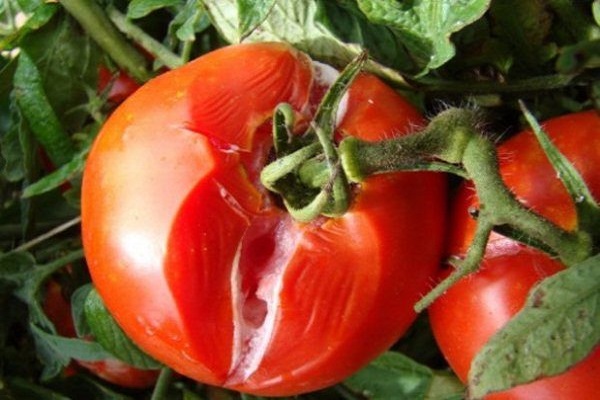
It is necessary to process tomatoes for diseases associated with the spread of white rot only at an early stage of development. This is done by spraying the bush with a solution of copper sulfate, urea, zinc.
Brown rot
The disease develops when the fungus gets under the tomato skin through its various damages. As the main symptom, the formation of a 4 cm putrefactive lesion on the tomatoes around the perimeter of the stalk. It is worth considering that under the skin, rot affects the fruit almost completely.
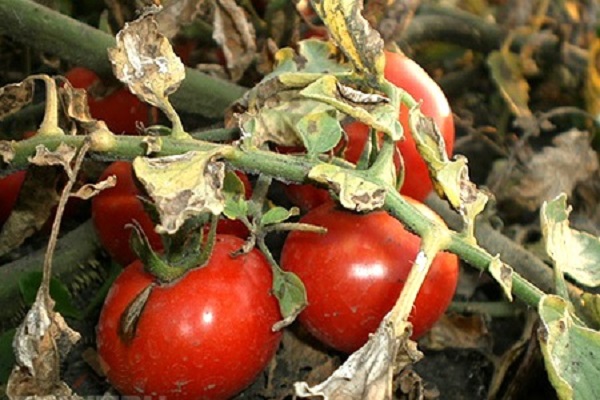
For the treatment of the disease and its prevention, many summer residents are advised to process the bushes with the Bordeaux mixture. Copper perchloric acid can also be used for these purposes.
Root rot
Another name for this disease is rhizoctoniasis. Basically, this pathology is detected when growing seedlings, but adult plants can also become infected with it due to an incorrect watering regime.

Description of characteristic symptoms:
- the roots of the plant culture first turn black, and then begin to rot;
- rot spreads to cuttings;
- then, first, the leaves wither and then dry;
- many brown spots appear on the leaves.
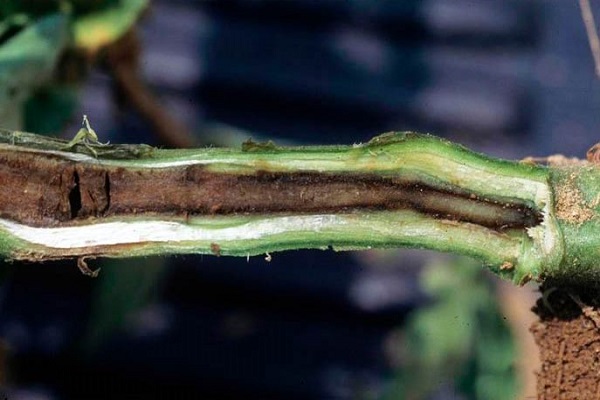
This tomato disease should be treated with Rossa or Pseudobacterin-2. During the treatment period, the plant culture should be watered rarely, but abundantly. In advanced cases, processing should be done with 0.25% Ridomila Gold.
Late blight
The activation of this disease of a tomato occurs when the phytophthora fungus enters the bush. Most often, this disease spreads in the summer-autumn season, accompanied by heavy rains. Also, the development of this disease can be caused by the rain irrigation method, in which excess moisture accumulates in the leaf sinuses.

You can determine this disease by the appearance of the following symptoms:
- the formation of brown spots on tomatoes;
- the appearance of brown drying areas on the trunk;
- darkening of some areas of the leaves.

How to spray affected plants? There are several different remedies that will help to cope not only with late blight of an early degree, but also eliminate neglected diseases. To treat the initial stage of disease development, you must use Fitosporin or Zaslon. For the treatment of advanced forms of late blight, affected plants need to be treated:
- Famoksadon;
- Mefenoxam;
- Mancozebom.
After using the listed drugs, you should not eat tomatoes harvested within 3 weeks after processing.
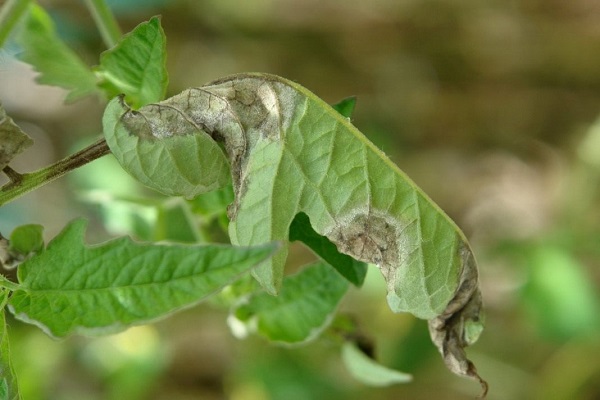
Stem necrosis
Stem necrosis is a viral disease that affects the formed bush during the period of ovary formation. Symptoms of tomato disease in a polycarbonate greenhouse and outdoors are:
- the spread of small dark green cracks that are located at the bottom of the stems;
- then aerial roots form on the cracks, while the plant becomes weak and begins to wither;
- eventually the tomatoes die.

The source of the disease is considered to be seeds that were taken for tomato seedlings, or infected soil. To stop the spread of this tomato disease in the greenhouse or outdoors, all infected plants are removed from the plot and burned.
How to spray the soil after culling
The best option for this would be a 2% solution of Fitolavin-300. Planting of the following seedlings should be carried out only in treated, protected ground. All of the described bacterial, fungal or viral diseases of tomatoes can greatly worsen the condition of a plant crop, not only reducing its yield, but also provoking death. Various diseases and pests of tomatoes can bypass planting if it has been properly planted and well cared for.

Before growing seedlings, it is necessary to process the taken seeds. And when transplanted into the ground, seedlings need to be treated with special prophylactic agents that prevent the development of diseases. If the summer resident does not have the strength and time to ensure proper planting care, he needs to choose those tomatoes whose varieties are resistant to diseases characteristic of a particular region.
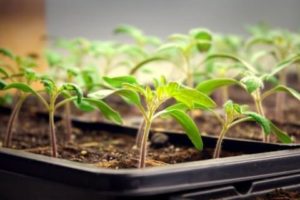
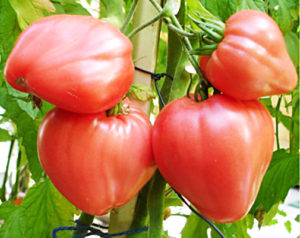
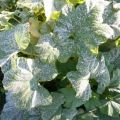

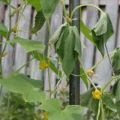
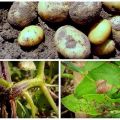
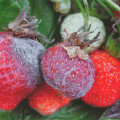



If the cause of the disease was not parasites, then you can use the remedy BioGrow, it saturates the soil well, thanks to which the tomato grows faster and without any problems.